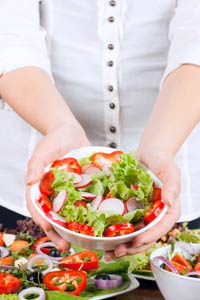10 Tips For Successful Weight Loss
Many people live in nations where the majority of people are overweight or obese. In the US, for example, only one-quarter of the adult population has an ideal weight.
In those ages 17 and under, 50% are at a normal weight. Less than 20% of those who lose weight keep that weight off, while the rest follow a circular pattern of weight loss, maintenance, followed by weight gain.
Carrying excess weight can lead to serious health problems such as heart disease, hypertension and type 2 diabetes. Dieting for weight loss is not a permanent solution. In order to lose weight safely and sustain that weight loss over time, permanent and healthy lifestyle changes must occur.
Fast facts on weight loss
Here are some key points about weight loss. More detail and supporting information is in the main article.
- Overweight and obesity result from a complex interaction between genes and the environment.
- Overweight is defined as a BMI of 25.0 to 29.9 kg/m2 and obesity as a BMI of 30 kg/m2 or above.
- Overweight and obesity increase health risks from hypertension, dyslipidemia, type 2 diabetes, heart disease, stroke, osteoarthritis and obstructive sleep apnea.
- The three major components of weight loss therapy are dietary therapy, increased physical activity and behavior therapy.
- Weight loss is primarily dependent on reducing total caloric intake, not the proportions of carbohydrate, fat and protein in the diet.
- Around 80% of persons who lose weight will gradually regain it. Individuals who continue weight maintenance programs have a greater chance of keeping weight off.
- To lose one pound a week, it is necessary to establish an energy deficit of 500 calories a day.
- Most weight loss occurs because of decreased caloric intake. Regular physical activity is most helpful in the prevention of weight regain.
- Low levels of physical activity are related to weight gain in both men and women.
- Record keeping has been shown to be one of the most successful behavioral techniques for weight loss and maintenance.
You will see introductions at the end of some sections to any recent developments that have been covered by MNT's news stories. Also look out for links to information about related conditions.
Losing weight
Successful weight loss does not require following a specific diet such as Weight Watchers or low glycemic, but rather eating less while moving more to achieve a negative energy balance. Weight loss is primarily dependent on reducing total caloric intake, not the proportions of carbohydrate, fat and protein in the diet.
Losing weight successfully requires achieving a negative energy balance rather than merely following a specific diet.
The amount of calories burned needs to be higher than calories consumed. When considering how to eat to maintain overall good health, diets should be rich in vegetables, fruit, whole grains, seafood, legumes, and nuts, and contain moderate amounts of dairy products as tolerated. Additionally, red and processed meat, sugar and refined grains should be limited, or avoided altogether.
A reasonable goal for weight loss is to strive for a 5-10% reduction in body weight over a 6-month time frame. Most people can achieve this goal by reducing their total caloric intake to somewhere between 1,000-1,600 calories per day. Diets of less than 1,000 calories per day are not recommended.
After 6 months of dieting, the rate of weight loss usually declines and weight plateaus because less energy is expended at the lower weight. A weight maintenance program of healthy eating habits and physical activity needs to be followed, or the lost weight will be regained.
For people who have a BMI greater than or equal to 30 with no obesity-related health problems, or for those with a BMI greater than or equal to 27 with obesity-related diseases, prescription weight-loss medications might be considered. Medications should only be used in addition to the above healthy lifestyle changes. If attempts to lose weight have failed and the BMI is greater than or equal to 40, surgical therapy is an option that can be considered.
Tips for successful weight loss
There are many steps that can be taken to improve your chances of losing weight and subsequently keeping it off. Below is a list of 10 tips that are likely to help.
1. Eat varied, colorful, nutritionally dense foods
The foundation of your diet should be healthy meals and snacks. A suggestion is to make each meal 50% fruit and vegetables, 25% whole grains, and 25% protein. Total fiber should be 20-30 g daily. Eliminate trans fats, and saturated fats should be kept as low as possible as their ingestion is strongly linked to the incidence of coronary heart disease. When fats are consumed, they should be monounsaturated (MUFA) or polyunsaturated (PUFA).
Foods to include: fresh fruits and vegetables, fish, legumes, nuts, seeds, and whole grains such as brown rice and oatmeal.
Foods to avoid: added oils and butter, non-lean red or processed meats, baked goods, bagels, white breads.
It is not uncommon to become deficient in necessary nutrients, vitamins and minerals while losing weight. Consult with a nutritionist or other knowledgeable clinician about how to prevent this during your weight loss program.
2. Keep a food and weight diary
Self-monitoring is one of the key elements in a successful weight loss program. Whether it be a paper diary, a mobile app or an Internet program, recording everything eaten over the course of the day is necessary. Weight should be measured and recorded weekly so as to follow progress.
3. Engage in regular physical activity and exercise
Physical activity is important for overall good health, and increasing it is another integral ingredient of a successful weight loss program.
Regular physical activity and exercise are crucial to losing weight successfully.
A total accumulation (activity can be portioned throughout the day) of one hour a day of moderate-intensity activity such as brisk walking is ideal. If one hour is not possible, 150-250 minutes per week is beneficial. For people who are not normally physically active, exercise should be initiated slowly and the intensity should be increased gradually.
Additionally, keep track of physical activity. There are many free mobile apps available to record food and activity that credit your calorie balance after you log your exercise. Activities like taking the stairs, raking leaves, dog walking, gardening, dancing, playing outdoor games and parking farther away from a building entrance are all good ways to increase your physical activity.
Medical evaluation prior to initiating an exercise program is typically not necessary for individuals at low risk for coronary heart disease. However, there are cases where medical evaluation is warranted. Consult your health care provider if you are unsure how much exercise is safe for you.
4. Eliminate liquid calories
It is easy to consume hundreds of calories a day from sugar-sweetened sodas, teas, juices or alcohol. This is a waste of your calories. Unless you are having a meal supplement healthy smoothie, drink water or unsweetened tea or coffee. Add a splash of fresh lemon or orange if you need taste. Don't mistake dehydration for hunger; if you think you are hungry and it is not a scheduled meal or snack time, have a drink of water.
5. Measure servings and control portions
Too much of any food, even low-calorie vegetables, will result in weight gain. Never make a habit of estimating a serving size or eating food right out of the bag. Use measuring cups, measurement guides or count out the appropriate amount for a serving. Guessing leads to overestimating and the potential to eat much more than what the serving really is.
If you are eating out, you can still have a good idea of how much you can eat by using these size comparisons:
- ¼ cup is a golf ball
- ½ cup is a tennis ball
- 1 cup is a baseball
- 1 ounce of nuts is a loose handful
- 1 teaspoon is 1 playing die
- 1 tablespoon is a thumb tip
- 3 ounces of meat is a deck of cards
- 1 slice is a DVD.
On the next page, we look at another five tips for successful weight loss, including mindful eating and planning ahead.
-
3 Easy Exercise Tips For Losing Belly Fat
If you want to lose belly fat, then you probably know that its ofte
-
Make Weight Loss A Reality With Advice That Works
Are you procrastinating when it comes to losing weight? Has some
-
The Scale Is Not Your Friend
Congratulations! Youve chosen to embark on a journey towards a healthi
-
Choosing the Right Sportswear for Your Routine
If you’ve decided to get fit it can be h
-
The Band FillAdjusting Your LapBand
A fill is nothing to be worried about. The actual procedure takes only
-
Baloney And The Fountain Of Youth
Lately Ive been receiving a lot of spam emails. Its amazing how many o
- DON'T MISS
- Lose Extra Weight Quickly
- The Truth Behind Hoodia Weight Loss Pills
- What is the Fastest Way to Lose Belly Fat
- How Many Calories Should I Consume To Lose Weight: Required Calorie Intake
- 7 Best Tips To Lose Belly Fat
- Maintaining Your Post Diet Weight
- Weight Loss What Is The Best Way To Lose Weight
- Diet And Exercise Program For Permanent Weight Loss Part 1
- Food - Enemy or Allly?
- Intestinal Parasites In Dogs




